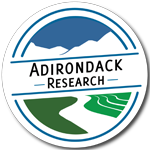Field Report: Hemlock Woolly Adelgid Spring Season
In March, Adirondack Research started six weeks of surveys in the Lake George area searching for hemlock woolly adelgid (HWA). Our goal was to complete early detection surveys, to find the invasive HWA while it was wintering, and to provide valuable information to local land conservancies so we can stop the spread of HWA as early as possible.
The invasive HWA feeds on Eastern hemlock trees and causes scar tissue to form, impacting the flow of water and nutrients for the tree and causing tree death in 4-10 years. In the 152,000 acre Lake George watershed, eastern hemlock accounts for 80% or more of the forested landscape. As a keystone tree species, hemlocks provide numerous ecological and cultural benefits to the landscape and stakeholders. The infestation and death of hemlocks in the area could affect the health of the land, water, and wildlife, as well as recreation opportunities and landscape aesthetics.
An HWA population was confirmed in Lake George in July 2020, so the surveys that Adirondack Research performed were meant as a rapid response to quickly detect any other populations of HWA. The sooner those populations are found, if present, the sooner they can be managed so that further spread of this invasive species can be prevented.
Over six weeks, we surveyed over 400 sites in the Lake George watershed with a field crew of 4 people, checking the leaves and branches of hemlock trees for the “white wool” of HWA. At about a quarter of those points, we did fixed radius stand composition surveys where we recorded the size and species of all the trees in a given forested area. Stand composition surveys allow us to use the recorded data to improve our satellite imaging model, which helps us identify potential sites where hemlock trees could be from NASA satellites.

Forest in the Lake George watershed. 
Using GIS to check for the next survey point. 
Checking for hemlock woolly adelgid. 
Measuring forest size and composition. 
Measuring forest size and composition.
All in all, our surveys found 1 new HWA infestation. The sites we visited that didn’t have HWA are currently healthy, and we will be able to check back in at those areas in the future to make sure they stay that way.
As the weather becomes warmer, we have had to pause our HWA surveys since the insects will be emerging for the spring and summer. We want to make sure we don’t accidentally transfer any HWA across Lake George and the Adirondacks, and it’s much easier to do that when HWA is active. Our surveys will start up again in the fall, partnered with other conservation organizations like the Adirondack park Invasive Plant Program, the Lake George Association/FUND for Lake George and the Lake George Land Conservancy.
If you think you’ve spotted any invasive species when you’re out and about, we suggest contacting the NYSDEC or the New York chapter of iMapInvasives: https://www.nyimapinvasives.org/report-an-invasive.
Images courtesy of Patrick Bly Photography.


Leave a Reply